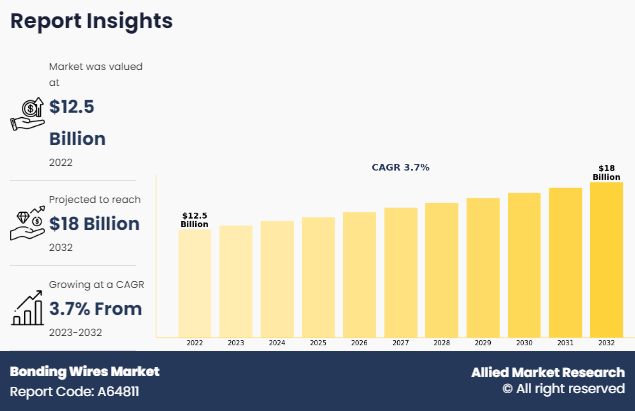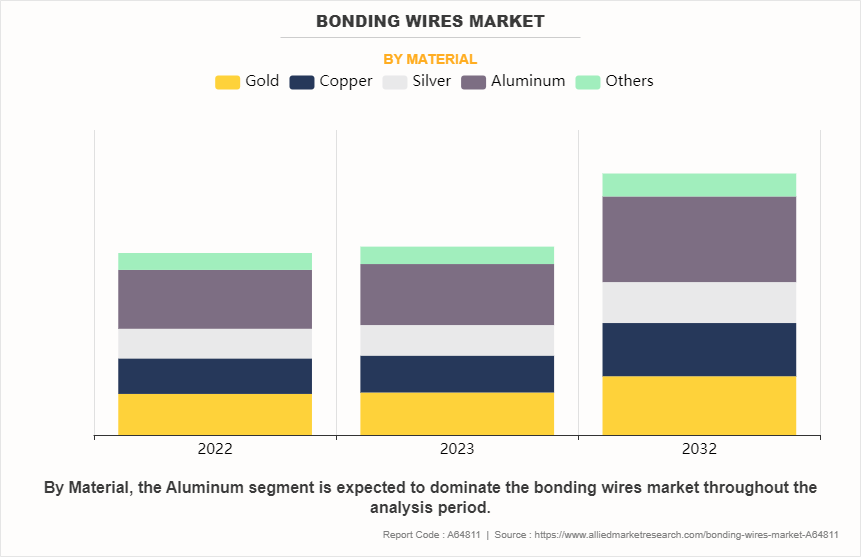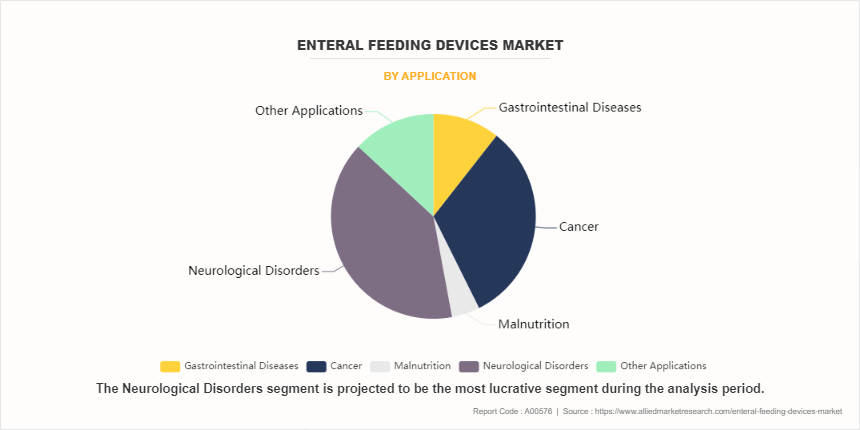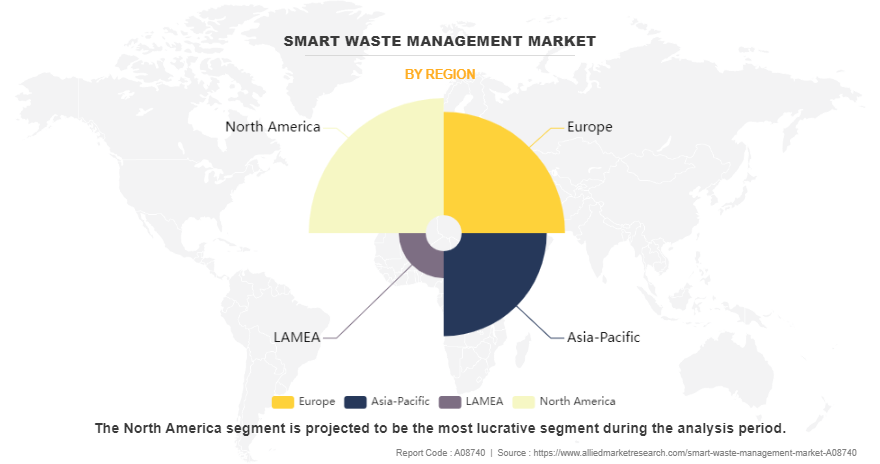Bonding Wires Market Overview
The global bonding wires market was valued at USD 12.5 billion in 2022, and is projected to reach USD 18.0 billion by 2032, growing at a CAGR of 3.7% from 2023 to 2032. Innovations in bonding wire materials and manufacturing processes can drive market growth by improving performance, reliability, and cost-effectiveness.
Key Market Trends
- The aluminum segment is projected to witness the fastest revenue growth in the global bonding wires market from 2023 to 2032.
- The integrated circuits segment emerges as the most lucrative application area in the bonding wires market.
- Asia-Pacific led the bonding wires market in 2022 and is expected to grow steadily at a CAGR of 4.3%.
Market Size & Forecast
- 2032 Projected Market Size: USD 18.0 billion
- 2022 Market Size: USD 12.5 billion
- Compound Annual Growth Rate (CAGR) (2023-2032): 3.7%

Introduction
Bonding wires are thin metallic connections used in semiconductor packaging to link the integrated circuit (IC) chip to its external leads or terminals. Typically made of gold, aluminum, or copper, they serve as conduits for electrical signals between different parts of the chip and its package. Bonding wires are meticulously engineered for reliability, conductivity, and mechanical strength, crucial for maintaining electrical connections amidst thermal expansions and contractions. They facilitate the transmission of signals and power within the semiconductor device, enabling proper functionality. As integral components in microelectronics assembly, bonding wires play a pivotal role in ensuring the performance and longevity of electronic devices and integrated circuits.
Key Takeaways:
- The bonding wires market report provides competitive dynamics by evaluating business segments, product portfolios, target market revenue, geographical presence and key strategic developments by prominent manufacturers.
- The bonding wires market forecast study contains qualitative information such as the market dynamics (drivers, restraints, challenges, and opportunities), key regulation analysis, pricing analysis, and Porter’s Five Force Analysis across North America, Europe, Asia-Pacific, LAMEA regions.
- Latest trends in global bonding wires market such as undergoing R&D activities, regulatory guidelines, and government initiatives are analyzed across 16 countries in 4 different regions.
- More than 3,300 bonding wire-related product literatures, industry releases, annual reports, and other such documents of key industry participants along with authentic industry journals and government websites have been reviewed for generating high-value industry insights for global bonding wires market statistics.
Market Dynamics:
The semiconductor industry serves as the primary driver for the bonding wires market. As the demand for semiconductor chips continues to rise across various applications such as consumer electronics, automotive, telecommunications, and industrial sectors, the need for bonding wires also escalates. The proliferation of smartphones, IoT devices, electric vehicles, and smart appliances fuels the demand for advanced semiconductor packages, thereby boosting the bonding wires market.
Moreover, continuous innovations in semiconductor packaging technologies drive the demand for advanced bonding wire solutions. Manufacturers are developing thinner, stronger, and more reliable bonding wires to meet the evolving requirements of semiconductor devices. Advancements such as copper bonding wires, fine pitch bonding, and advanced wire bonding techniques enhance the performance, efficiency, and reliability of electronic devices, stimulating bonding wires market growth.
However, as semiconductor devices become smaller and more complex, the demand for finer wire diameters and tighter pitch spacing increases. However, achieving these requirements poses significant technological challenges for bonding wire manufacturers. Miniaturization demands high precision and advanced manufacturing processes, which may lead to increased production costs and reduced yield rates.
On the contrary, the trend towards miniaturization of electronic devices necessitates the development of finer pitch bonding wires capable of accommodating denser interconnects within smaller semiconductor packages. Bonding wire manufacturers are focusing on producing ultra-fine wires with reduced diameters to address the miniaturization requirements of modern electronics, thereby expanding the bonding wires market opportunities.
Segment Overview:
The bonding wires market is segmented on the basis of material, product type, application, and region. On the basis of material, the market is categorized gold, copper, aluminum, silver, and others. By application, the market is divided into integrated circuits, transistors, sensors, and others. Region-wise, the market is studied across North America, Europe, Asia-Pacific, and LAMEA.

In 2022, the aluminum segment was the largest revenue generator, and is anticipated to grow at a CAGR of 3.8% during the forecast period. With the trend towards smaller, lighter electronic devices such as smartphones, tablets, wearables, and IoT devices, there is a growing need for materials that can meet the requirements of miniaturization while maintaining performance. Aluminum bonding wire provides a lightweight alternative to traditional copper bonding wire, contributing to the overall weight reduction of electronic devices. Moreover, aluminum is generally cheaper than copper, making aluminum bonding wire a more cost-effective option for manufacturers. As the demand for electronic devices continues to rise, cost-effective materials become increasingly important for manufacturers looking to maintain competitiveness in the market.

By application, the integrated circuits segment dominated the global bonding wires market share in 2022, and is anticipated to grow at a CAGR of 3.4% during the forecast period. As integrated circuits become more complex and advanced, the demand for finer wire bonding technologies increases. Bonding wire is essential for making electrical connections between the IC chip and the package or substrate. With advancements in IC design and packaging, the requirements for bonding wire in terms of diameter, material composition, and performance characteristics are becoming more stringent. Moreover, the trend towards smaller and thinner electronic devices, driven by consumer demands for sleeker and more portable gadgets, necessitates finer wire bonding technology. Bonding wire plays a crucial role in enabling the miniaturization of IC packages by providing reliable electrical connections in a compact space.

The Asia-Pacific bonding wires market size is projected to grow at the highest CAGR of 4.3% during the forecast period and accounted for more than 40% of bonding wire market share in 2022. The Asia-Pacific region is a hub for electronics manufacturing, with countries like China, Japan, South Korea, Taiwan, and Singapore playing significant roles in the global supply chain. As the demand for electronic devices continues to rise worldwide, driven by factors such as urbanization, rising disposable incomes, and technological advancements, there is a corresponding increase in the demand for bonding wire to support the production of semiconductors and electronic components. Furthermore, the Asia-Pacific region is experiencing rapid industrialization and urbanization, leading to increased demand for electronic devices in various sectors such as consumer electronics, automotive, telecommunications, and industrial automation. These sectors require a wide range of integrated circuits and semiconductor components, driving the growth of the bonding wires industry wherein used in their assembly and packaging.
Which are the Top Bonding Wires companies
The following are the leading companies in the market. These players have adopted various strategies to increase their market penetration and strengthen their position in the bonding wires industry.
- Tanaka Holdings Co., Ltd.
- Heraeus Holding GmbH
- TATSUTA Electric Wire & Cable Co., Ltd.
- Sumitomo Metal Mining Co., Ltd.
- MK Electron Co., Ltd.
- Yantai Zhaojin Kanfort Precision Machinery Co., Ltd.
- Shinkawa Electric Co., Ltd.
- AMETEK Electronic Components and Packaging
- TANAKA Denshi Kogyo K.K.
- NIPPON STEEL Chemical & Material Co., Ltd.
Key Benefits for Stakeholders
- This bonding wires market report provides a quantitative analysis of the market segments, current trends, estimations, and dynamics of the bonding wires market analysis from 2022 to 2032 to identify the prevailing bonding wires market opportunities.
- The market research is offered along with information related to key drivers, restraints, and opportunities.
- Porter's five forces analysis highlights the potency of buyers and suppliers to enable stakeholders make profit-oriented business decisions and strengthen their supplier-buyer network.
- In-depth analysis of the bonding wires market segmentation assists to determine the prevailing market opportunities.
- Major countries in each region are mapped according to their revenue contribution to the global market.
- Market player positioning facilitates benchmarking and provides a clear understanding of the present position of the market players.
- The report includes the analysis of the regional as well as global bonding wires market trends, key players, market segments, application areas, and market growth strategies.
Bonding Wires Market Report Highlights
| Aspects | Details |
| Market Size By 2032 | USD 18 billion |
| Growth Rate | CAGR of 3.7% |
| Forecast period | 2022 - 2032 |
| Report Pages | 510 |
| By Material |
|
| By Application |
|
| By Region |
|
| Key Market Players | NIPPON STEEL Chemical & Material Co., Ltd., Sumitomo Metal Mining Co., Ltd., SHINKAWA Electric Co., Ltd., Tanaka Holdings Co., Ltd., Yantai Zhaojin Kanfort Precision Machinery Co., Ltd., AMETEK Electronic Components And Packaging, MK Electron Co., Ltd., TANAKA Denshi Kogyo K.K., Heraeus Holding GmbH, TATSUTA Electric Wire & Cable Co., Ltd. |
Analyst Review
According to the CXOs of leading companies, the bonding wire market is driven by a combination of factors, including the growing demand for semiconductor devices, technological advancements, miniaturization trends, increasing investments in semiconductor manufacturing, the rise of electric vehicles and autonomous vehicles, expansion of 5G infrastructure and IoT ecosystem, emergence of advanced applications in AI, machine learning, and edge computing, and focus on environmental sustainability and cost optimization. These drivers collectively contribute to the dynamic growth and evolution of the bonding wire market, presenting lucrative opportunities for stakeholders across the semiconductor and electronics value chain.
Growing demand for semiconductor devices, technological advancements in bonding wire material, miniaturization trends, and increasing investments in semiconductor manufacturing are the upcoming trends of Bonding Wires Market in the world.
Integrated circuits is the leading application of Bonding Wires Market.
Asia-Pacific is the largest regional market for Bonding Wires.
The global bonding wire market was valued at $12.5 billion in 2022 and is estimated to reach $18.0 billion by 2032, exhibiting a CAGR of 3.7% from 2023 to 2032.
The global bonding wire market profiles leading players that include Tanaka Holdings Co., Ltd., Heraeus Holding GmbH, TATSUTA Electric Wire & Cable Co., Ltd., Sumitomo Metal Mining Co., Ltd., MK Electron Co., Ltd., Yantai Zhaojin Kanfort Precision Machinery Co., Ltd., Shinkawa Electric Co., Ltd., AMETEK Electronic Components and Packaging, TANAKA Denshi Kogyo K.K., and NIPPON STEEL Chemical & Material Co., Ltd.
Loading Table Of Content...
Loading Research Methodology...



